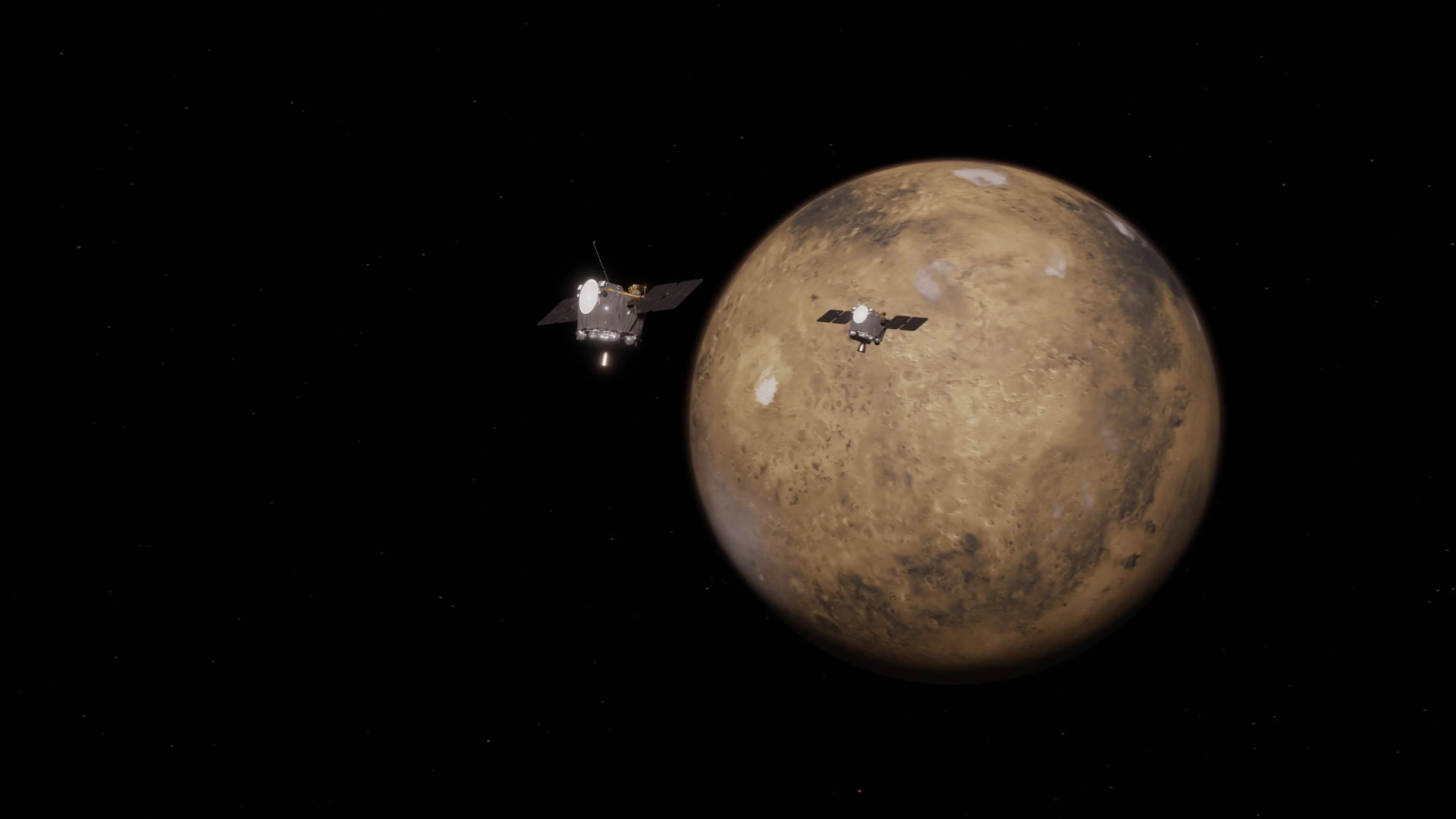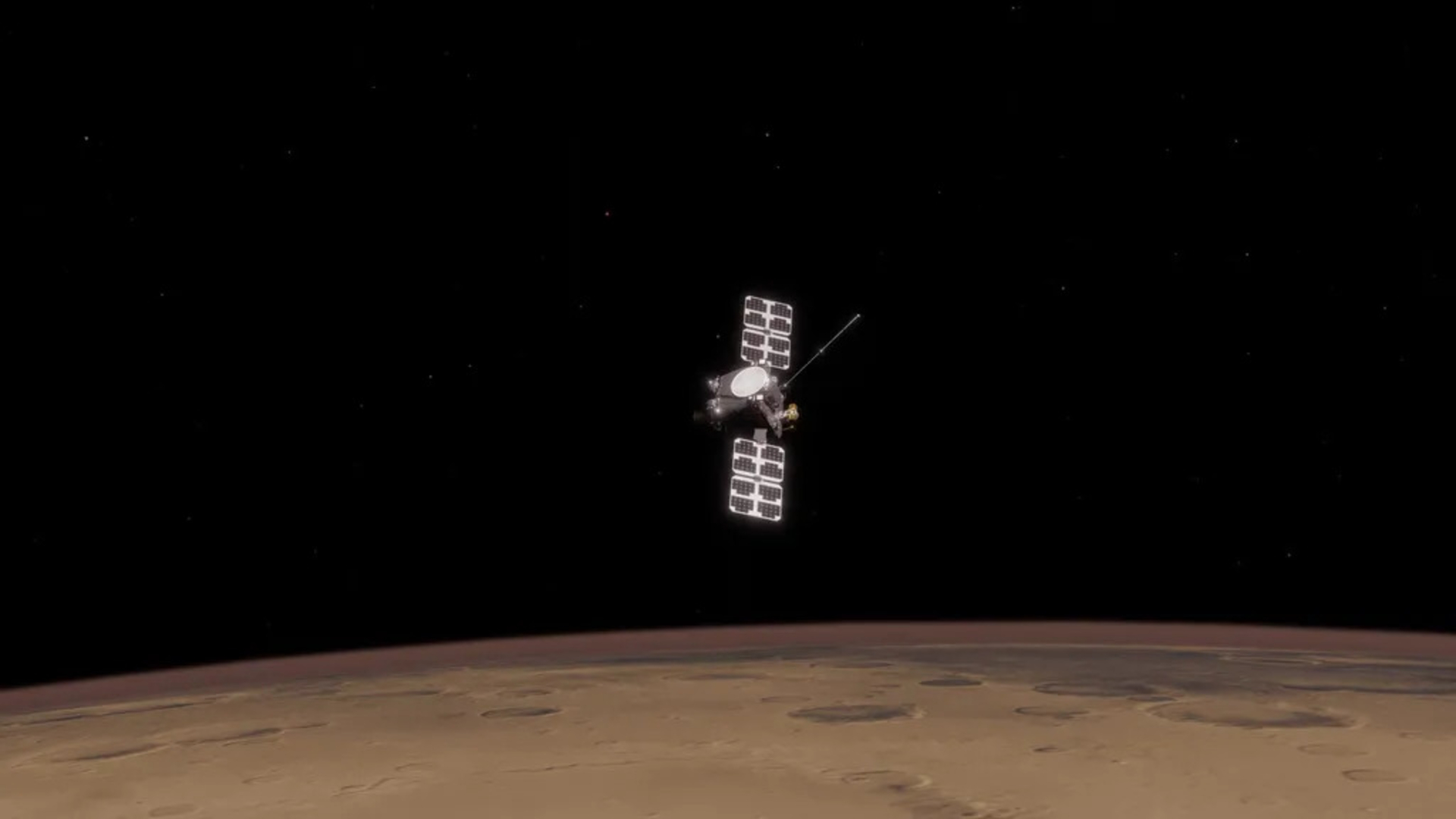NASA's new Mars mission: These twin satellites could reveal how the Red Planet lost its atmosphere
NASA's first dual-satellite mission to another planet, ESCAPADE, is slated to launch this weekend.

Mars is about to receive a double dose of attention. This weekend, a pair of identical NASA satellites will launch together to help reveal how the Red Planet lost its thick atmosphere and liquid water — one of its oldest mysteries, and a key to understanding how it transformed from a once-habitable world into the frozen desert it is today.
Scheduled for liftoff no earlier than Sunday (Nov. 9) aboard Blue Origin's New Glenn rocket from Cape Canaveral, Florida, the $80 million ESCAPADE mission — short for Escape and Plasma Acceleration and Dynamics Explorers — will send two twin probes, nicknamed Blue and Gold, to orbit Mars in tandem. The mission marks NASA's first dual-satellite mission to another planet, and aims to create a 3D view of how the solar wind, the stream of charged particles from the sun, energizes and strips away Martian air.
"To understand how the solar wind drives different kinds of atmospheric escape is a key piece of the puzzle of the climate evolution of Mars," Robert Lillis, principal investigator for ESCAPADE and associate director for planetary science at the University of California, Berkeley's Space Sciences Laboratory, said in a statement released Wednesday (Nov. 5). "ESCAPADE gives us what you might call a stereo perspective — two different vantage points simultaneously."
Geologic evidence from ancient river valleys and water-formed minerals shows that Mars once had liquid water, which means it also had a much thicker atmosphere. But around 4 billion years ago, the planet's magnetic field, which is the invisible shield that protects a world from the sun's radiation, began to fade. Without that protection, the solar wind slowly stripped away the Martian atmosphere, leaving behind a tenuous wisp less than 1% as dense as Earth's.
Previous missions, including NASA's Mars Global Surveyor, MAVEN, and the Emirates Mars Mission Hope, have shown that Mars lacks a global magnetic field but retains patchy magnetic "bubbles" locked into its crust. However, with only one spacecraft in orbit at a time, researchers have been limited to viewing one region at a time, often hours apart.
With the ESCAPADE satellites, "we can monitor how those regions vary on timescales as short as two minutes and up to 30 minutes," Lillis said in the statement. "This will allow us to really make measurements we've never made before, and to characterize a very dynamic system in a way we couldn't characterize it before."
After reaching Mars in September 2027, the robotic duo will spend about seven months fine-tuning their orbits before flying in formation, like a "pair of pearls on a string," coming within 100 miles (160 kilometers) above the surface. If all goes to plan, after six months of joint observations, they will separate into different orbits for another five months to build a 3D map of how energy and matter flow between Mars and the solar wind, the process that controls atmospheric loss.
Breaking space news, the latest updates on rocket launches, skywatching events and more!
Over roughly 11 months of science operations, ESCAPADE will explore three key questions, including how Mars’ magnetic bubble is shaped, how energy from the sun interacts with it, and how this affects the flow of particles in and out of the planet’s atmosphere.
To achieve this, each probe, about the size of a copy machine, carries an identical suite of instruments working in concert. Electrostatic analyzers, built at UC Berkeley, will detect charged particles escaping from Mars; by measuring their direction and energy, scientists can determine whether those particles are falling back toward the planet or being swept away by the solar wind, the statement says.
A magnetometer from NASA's Goddard Space Flight Center will track the strength and orientation of magnetic fields, while plasma sensors from Embry-Riddle Aeronautical University will probe plasma properties. Meanwhile, student-built cameras from Northern Arizona University will capture images of Mars, and may even catch glimpses of its mysterious green auroras.
ESCAPADE is also testing a clever new route to Mars. Instead of heading directly to Mars, the spacecraft will first gear toward a Lagrange point, a gravitational “sweet spot” between Earth and the sun, for about a year before slingshotting toward Mars in 2026. This longer but more flexible route could make future missions less dependent on the narrow, once-every-two-years Mars launch windows, scientists say.
Understanding how solar radiation interacts with Mars' upper atmosphere, known as the ionosphere, could also aid future explorers. On Mars, radio waves can reflect off the ionosphere to travel beyond the horizon, so mapping how this layer behaves will be vital for communication and navigation. The mission's results may even hint at whether liquid water still lingers underground, a possibility supported by recent analyses of seismic data from NASA's InSight lander — and a key question for future human exploration.
"It is definitely going to be a challenge to establish a human settlement on Mars," Lillis said in the same statement. "But, you know, humans are tenacious, right?"

Sharmila Kuthunur is an independent space journalist based in Bengaluru, India. Her work has also appeared in Scientific American, Science, Astronomy and Live Science, among other publications. She holds a master's degree in journalism from Northeastern University in Boston.
You must confirm your public display name before commenting
Please logout and then login again, you will then be prompted to enter your display name.

